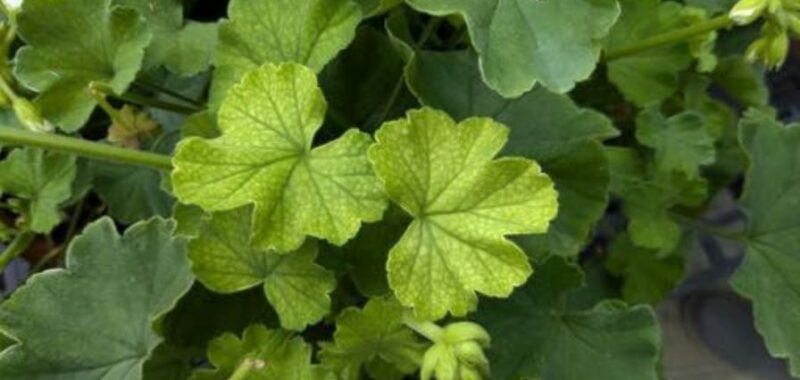
Multiples geranium leaves with manganese deficiency symptoms | Brian Whipker
Brian E. Whipker and Patrick Veazie of North Carolina State University talked about running nutritional deficiency experiments on plants in a recent e-Gro alert, stating, “These controlled experiments have allowed us to view unique symptomology on plants,” with geraniums being a reoccurring contributor. This is because geraniums have many routine and observable problems, including low or high pH and nitrogen and magnesium deficiencies. However, a more unique and rare problem to encounter and diagnose is the appearance of micronutrient deficiencies.
Geraniums – Pronounced, Popping Veins
A recent investigation of some geraniums involved in such trials displayed unique leaf symptomology, with small and pronounced veination (veins popping out). While not dissimilar to other nutritional issues, the pair were able to narrow down the cause of manganese deficiency in the geraniums.
Manganese Deficiency in Geraniums
Due to the rarity of the condition and its symptom similarity to those from other nutrient deficiencies, Whipker and Veazie performed leaf tissue analysis to confirm the diagnosis of the geraniums. With a normal range of manganese in geraniums set between 50 to 325 ppm (parts per million) according to the Plant Analysis Handbook, the leaves that underwent the analysis came back with a reading of 30.5. So, what is causing this particular and rare nutrient deficiency in the geraniums?
Management and Solutions for Geranium Manganese Deficiency
Whipker and Veazie hypothesize that the nutrient issue relates to the plant’s fertilization routine. A more frequent regime, along with making sure the fertilizer of choice is flush with the needed micronutrients, is likely to solve the problem.
Additionally, the substrate pH should be checked and maintained to ensure it’s not running high, which is often a source of countless nutritional problems in plants.
For a last resort, the pair recommend an application of manganese chelate. However, they stress that if the substrate pH level is too low, such an application will likely result in the proliferation of toxicity symptoms, leading to more severe and additional problems to tackle.
For more information regarding the cause and solutions to manganese and micronutrient deficiencies in geraniums, please read the full e-Gro (Electronic Grower Resources Online) alert “Maintaining Manganese: Pronounced Veination of Young Geranium Leaves.” Additional and current e-Gro alert pieces from Volume 13 (2024) can be found online.

